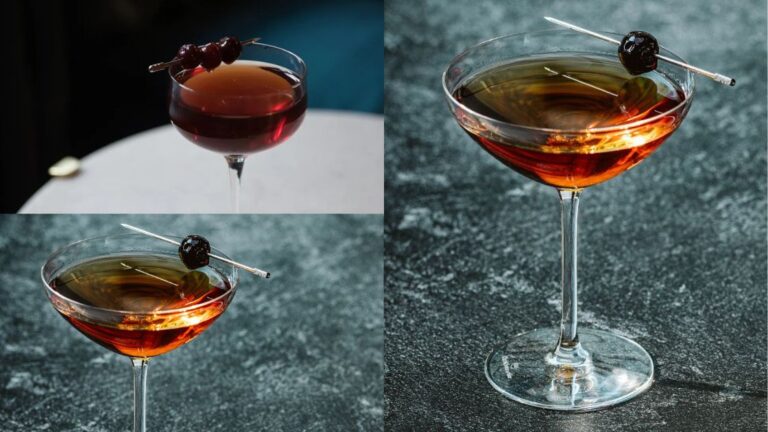Whiskey, a timeless and globally cherished spirit, has captivated the hearts of connoisseurs and casual drinkers alike with its rich flavors and diverse styles. Originating from various parts of the world, each type of whiskey tells a unique story through its distinct taste and aroma, shaped by centuries of tradition and craftsmanship. Among the myriad varieties, two categories often spark curiosity and debate: Single-Grain and Single-Malt Whiskey. While both hail from the prestigious family of whiskies, their differences in production, flavor profiles, and cultural significance are profound. This article delves into the intriguing world of Single-Grain and Single-Malt Whiskey, unraveling the nuances that set them apart and celebrating the rich heritage that makes each one exceptional in its own right. Whether you’re a whiskey aficionado or a newcomer eager to explore, understanding these differences is key to appreciating the art and science behind one of the world’s most beloved spirits.
The Basics of Whiskey
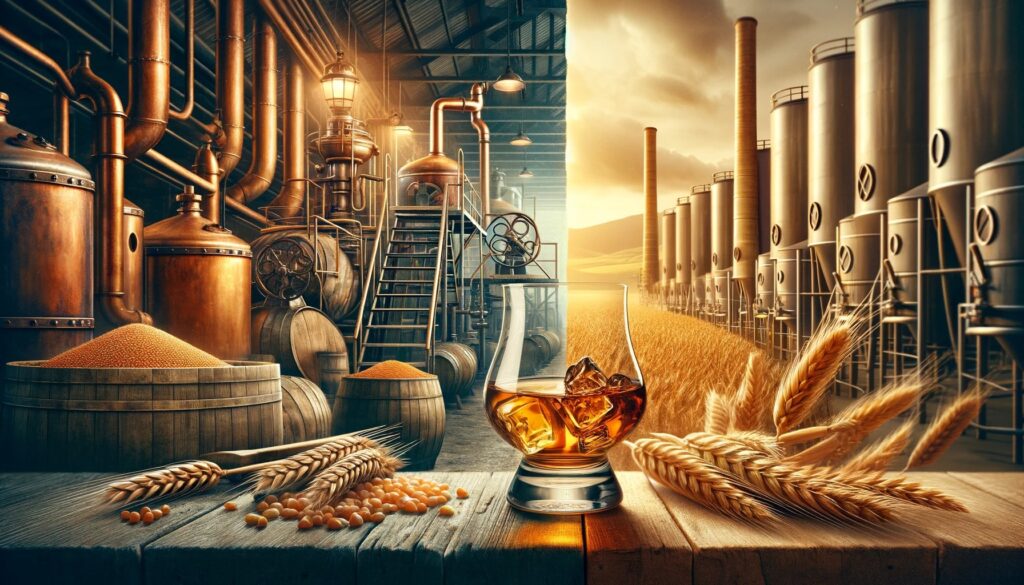
Definition of Whiskey
Whiskey, at its core, is a distilled alcoholic beverage made from fermented grain mash. The grains used can include barley, corn, rye, and wheat, which contribute to the diverse flavors and types of whiskey found around the world. What distinguishes whiskey from other spirits is not just the ingredients, but also its aging process. By law, it must be aged in wooden barrels, often oak, which impart distinct characteristics to the final product. The duration of aging, the type of wood used, and the previous contents of the barrels (if any) play crucial roles in defining the whiskey’s flavor profile.
General Process of Whiskey Making
- Mashing: The process begins with mashing, where the grains are ground and mixed with water to create a mash. This step is crucial for converting the starches in the grains into fermentable sugars.
- Fermentation: The mash is then fermented. Yeast is added to convert the sugars into alcohol, resulting in a liquid known as ‘wash’ with low alcohol content.
- Distillation: The wash is then distilled, usually in copper stills. Distillation increases the alcohol content and helps to purify the liquid. The art of distillation lies in separating the desirable alcohols from the undesirable ones, a process often repeated to enhance the quality of the spirit.
- Aging: The distilled spirit, now called ‘new make spirit,’ is aged in barrels. The aging process is where whiskey acquires its color, character, and a significant portion of its flavor. The length of aging can vary greatly, from a few years to several decades.
- Bottling: After aging, the whiskey may be blended or diluted with water to achieve the desired flavor and alcohol content. It is then bottled and ready for consumption.
The global appreciation of whiskey stems from its complex flavors and the intricate process of its making, which combines tradition, skill, and a touch of artistry. As we venture into the specifics of Single-Grain and Single-Malt Whiskey, these fundamental principles lay the groundwork for understanding their unique characteristics.
Understanding Single-Malt Whiskey
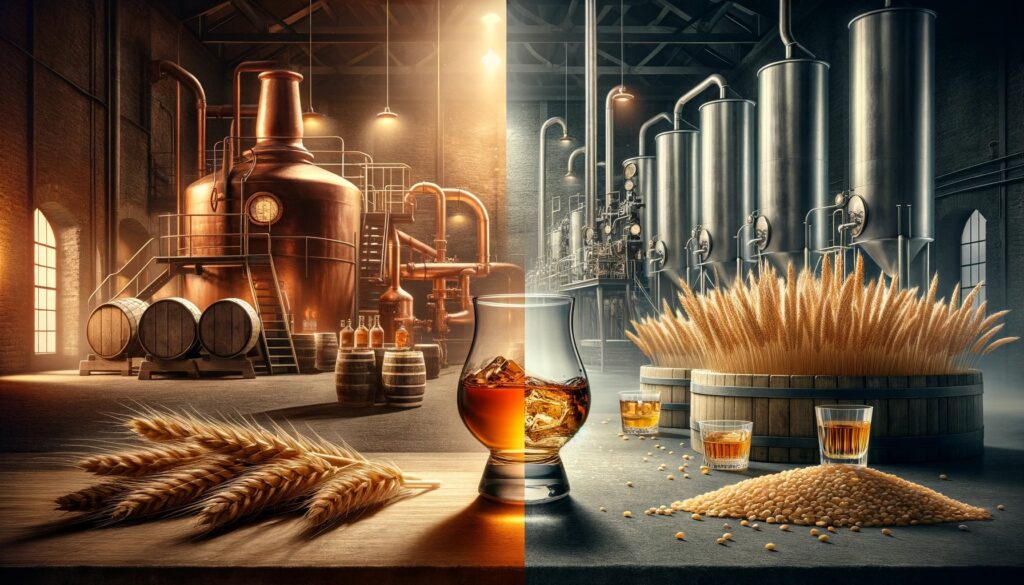
Definition of Single-Malt Whiskey
Single-Malt Whiskey is a type of whiskey made using a single grain ingredient, traditionally malted barley, at a single distillery. The term “single” signifies that the whiskey comes from one distillery, offering a distinct expression of the location’s water, climate, and distillation techniques. Single-Malt Whiskeys are renowned for their depth of flavor and complexity.
Key Characteristics
- Flavor Profile: Typically, Single-Malts exhibit a rich and varied flavor profile, which can range from light and floral to rich and smoky, depending on the production methods and region.
- Texture: They often have a fuller body and a more pronounced malt character than their grain-based counterparts.
- Color: The color can vary significantly, influenced by the type of cask used for aging.
Production Process
- Malting:
- The process starts with malting the barley, where it’s soaked in water and allowed to germinate.
- Once germinated, the barley is dried in a kiln. Peat may be used in the drying process, adding a smoky character to the whiskey.
- Distillation:
- Single-Malt Whiskey is typically distilled twice (and sometimes three times in some Irish and Scottish distilleries) in pot stills.
- The shape and size of the pot stills influence the character and flavor of the whiskey.
- Aging:
- The distilled spirit is aged in oak barrels. The choice of barrels (new, used, bourbon, sherry, etc.) affects the flavor.
- The minimum aging period is usually three years, but many single malts are aged much longer to develop complexity.
Regions Known for Single-Malt
- Scotland: The heartland of Single-Malt, with regions like Speyside, Islay, and the Highlands, each offering distinct flavors (from sweet and floral to peaty and smoky).
- Ireland: Known for triple-distilled, smooth, and often fruitier Single-Malts.
- Other regions like Japan and the United States are also gaining recognition for their quality Single-Malt Whiskeys.
Single-Malt Whiskey’s appeal lies in its ability to capture and convey the essence of the place and people who make it. From the selection of the barley to the final aging process, every step is a testament to the tradition and craftsmanship inherent in this beloved spirit.
Exploring Single-Grain Whiskey

Definition of Single-Grain Whiskey
Single-Grain Whiskey refers to whiskey made at a single distillery, but unlike Single-Malt, it includes a combination of malted barley and other grains. These additional grains can include corn, wheat, or rye, and they are often used in larger proportions than malted barley. The term “single-grain” does not imply the use of a single type of grain but rather that the whiskey is produced at a single distillery.
Composition and Ingredients
- Diverse Grain Mix: The use of grains other than barley, like corn or wheat, is a distinguishing feature. Each grain contributes differently to the flavor profile.
- Malted Barley: A portion of malted barley is still used, primarily for its enzymes which aid in the fermentation process.
Production Process Differences from Single-Malt
- Distillation:
- Single-Grain Whiskey is often distilled in continuous column stills, which is more efficient than the pot stills used for Single-Malts.
- This method allows for a higher alcohol content and a lighter spirit.
- Flavor Profile:
- The use of different grains and distillation method results in a lighter and often sweeter flavor profile compared to Single-Malts.
- The nuances of the individual grains are more pronounced.
- Aging:
- Like Single-Malts, Single-Grain Whiskeys are aged in oak barrels, but they may respond differently to the aging process due to their distinct composition.
Notable Single-Grain Whiskey Producing Regions
- Scotland: Known for producing exceptional Single-Grain Whiskeys, often used as a component in blended Scotch.
- Ireland: Also produces notable Single-Grain Whiskeys, with a smooth and light character.
- United States: While not as commonly associated with Single-Grain production, there are distilleries experimenting with this style.
Single-Grain Whiskey, while perhaps less known than Single-Malt, offers a unique and approachable experience. Its versatility in composition allows for a broad spectrum of flavors and styles, making it an exciting category for whiskey enthusiasts to explore. The innovation and experimentation in grain selection and production processes among different regions contribute to the growing interest and appreciation for Single-Grain Whiskey.
Comparing Single-Malt and Single-Grain Whiskey
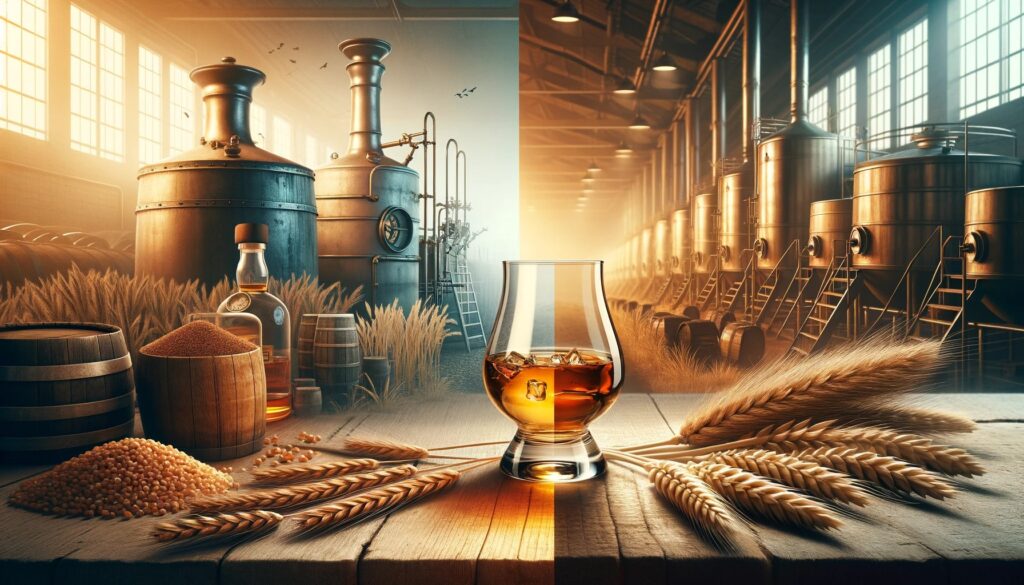
The world of whiskey presents a fascinating array of flavors and styles, with Single-Malt and Single-Grain Whiskeys standing out for their distinctive characteristics. Understanding their differences is key to appreciating the craftsmanship behind each.
Differences in Ingredients
- Single-Malt Whiskey: Exclusively made from malted barley. The absence of other grains focuses the flavor profile on the characteristics of the barley and the malting process.
- Single-Grain Whiskey: Includes a variety of grains such as corn, wheat, or rye, in addition to malted barley. This diversity in grains creates a broader flavor palette and influences the texture and taste of the whiskey.
Production Process Contrasts
- Distillation:
- Single-Malt is typically distilled in traditional pot stills, which contribute to a richer, fuller flavor.
- Single-Grain generally employs continuous column stills, leading to a higher alcohol yield and a lighter, cleaner spirit.
- Scale of Production:
- Single-Malt distilleries often operate on a smaller scale, focusing on artisanal techniques.
- Single-Grain distilleries can produce larger quantities due to the efficiency of the column stills.
Flavor Profiles
- Single-Malt Whiskey: Known for its depth and complexity, with potential flavor notes ranging from sweet and fruity to peaty and smoky, depending on the region and production methods.
- Single-Grain Whiskey: Typically lighter and smoother, often with sweet undertones. The additional grains can impart subtle nuances, making it versatile for both sipping and blending.
Aging Process Variations
- Both types are aged in oak barrels, but the reaction to the aging process can vary.
- Single-Malt:
- The interaction with the oak is crucial, often resulting in a more pronounced change in flavor over time.
- The choice of cask (e.g., sherry, bourbon, new oak) can significantly influence the flavor.
- Single-Grain:
- Tends to have a more subtle interaction with the oak.
- The aging process can mellow the spirit and add complexity, but the grain flavors remain more prominent.
In summary, Single-Malt and Single-Grain Whiskeys offer diverse experiences due to differences in their ingredients, production processes, flavor profiles, and aging. Single-Malt is often celebrated for its depth and traditional craftsmanship, while Single-Grain offers a lighter, more versatile profile, showcasing the unique qualities of different grains. Both styles embody the rich heritage and innovation of whiskey-making, catering to a wide range of palates and preferences.
The Role of Geography in Whiskey Production
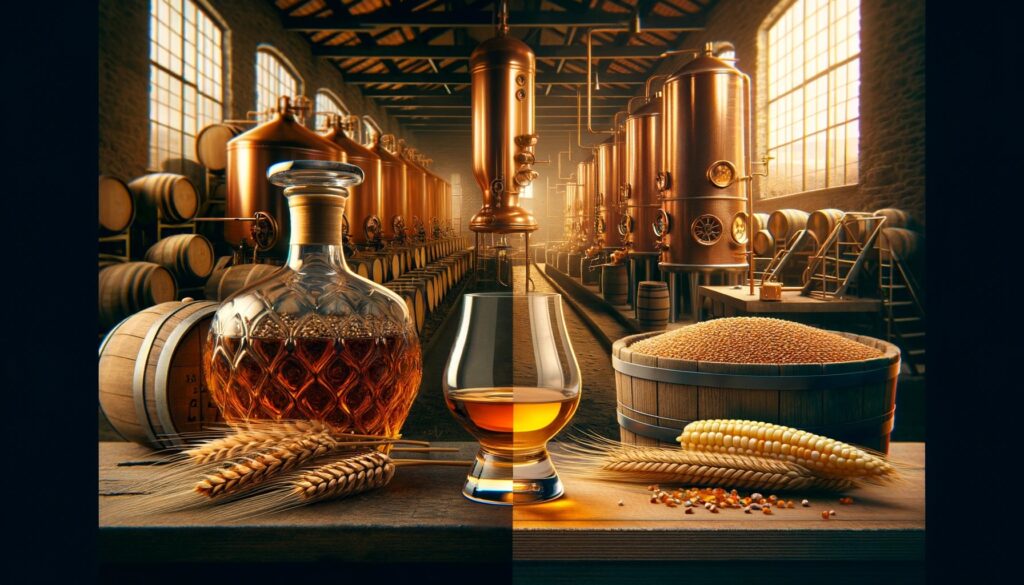
How Location Affects the Taste and Production
Geography plays a pivotal role in shaping the characteristics of whiskey. Factors like climate, water source, and local ingredients all influence the taste and production of whiskey.
- Climate: The temperature and humidity of a region affect the aging process. In warmer climates, whiskey matures faster due to increased interaction with the wood of the barrels.
- Water Source: The purity and mineral content of the local water used during production can significantly impact the flavor. Water used in mashing and diluting the spirit is a key component of the final taste.
- Terroir: Similar to wine, the concept of terroir, which includes local climate, soil, and topography, influences the flavor of the grain and, consequently, the whiskey.
- Cultural Techniques: Traditional methods and local practices in whiskey-making, handed down through generations, also contribute to regional flavor profiles.
Regional Specialties in Single-Malt and Single-Grain Whiskey
- Scotland:
- Single-Malt: Regions like Speyside are known for smooth and sweet malts, while Islay is famous for heavily peated, smoky whiskies.
- Single-Grain: Often lighter and used in blends, but also available as premium aged expressions.
- Ireland:
- Single-Malt: Known for triple distillation, resulting in smooth and fruity flavors.
- Single-Grain: Typically light and smooth, often aged in bourbon casks for a sweet vanilla flavor.
- United States:
- While more known for Bourbon and Rye, there are craft distilleries producing Single-Malt and Single-Grain Whiskeys with unique American characteristics, often using innovative aging techniques.
- Japan:
- Single-Malt: Japanese whiskies have gained international acclaim for their elegance and balance, often drawing inspiration from Scottish techniques but with a distinct Japanese refinement.
- Single-Grain: While less common, Japanese Single-Grain whiskies are known for their craftsmanship and quality.
Geographical factors not only influence the flavor and character of the whiskey but also contribute to the identity and heritage of the spirit. Each region brings its unique stamp to the world of whiskey, creating a rich tapestry of flavors and styles. From the peaty depths of Scottish Single-Malts to the smooth subtlety of Irish Single-Grains, the influence of geography is profound and indispensable in the art of whiskey-making.
Price and Availability

Market Trends: Availability and Price Range
- Single-Malt Whiskey:
- Generally more expensive due to the longer and more artisanal production process.
- Limited editions and older age statements can significantly increase the price.
- Widely available, but rare or aged bottles might be harder to find.
- Single-Grain Whiskey:
- Typically more affordable than Single-Malt, making it a popular choice for everyday consumption.
- Rare or aged Single-Grain expressions can also command higher prices.
- Availability varies, with a growing presence in the market as interest in this category increases.
Factors Affecting the Cost of Single-Malt vs. Single-Grain
- Production Costs:
- Single-Malt requires traditional pot still distillation and often uses 100% malted barley, which is more expensive.
- Single-Grain, made in more efficient column stills and using a mix of grains, can be produced at a lower cost.
- Aging Process:
- The length of time and the type of casks used for aging contribute to the cost. Older whiskies and those aged in rare or unique casks (like sherry or port barrels) are usually more expensive.
- Brand and Rarity:
- Limited releases, special editions, and whiskies from renowned distilleries often carry a premium price.
- The rarity of a whiskey, whether Single-Malt or Single-Grain, can increase its value significantly.
- Region and Importing Costs:
- Whiskies from regions with a high reputation (like Scotch or Japanese whiskies) may be priced higher.
- Import taxes and duties also affect the final retail price, especially in international markets.
- Market Demand:
- The popularity and demand for certain types of whiskey can drive up prices.
- Single-Malt has traditionally enjoyed a more premium status, which is often reflected in its pricing.
The pricing of Single-Malt and Single-Grain Whiskey is influenced by a combination of production methods, aging duration, brand prestige, regional factors, and market demand. While Single-Malts generally command a higher price due to their complex production and aging processes, Single-Grain whiskies offer a more affordable alternative without compromising on quality, with certain aged and rare expressions providing premium options for enthusiasts. The evolving market trends reflect a growing appreciation for both styles, with increasing availability and options for consumers.
Selecting the Right Whiskey for You
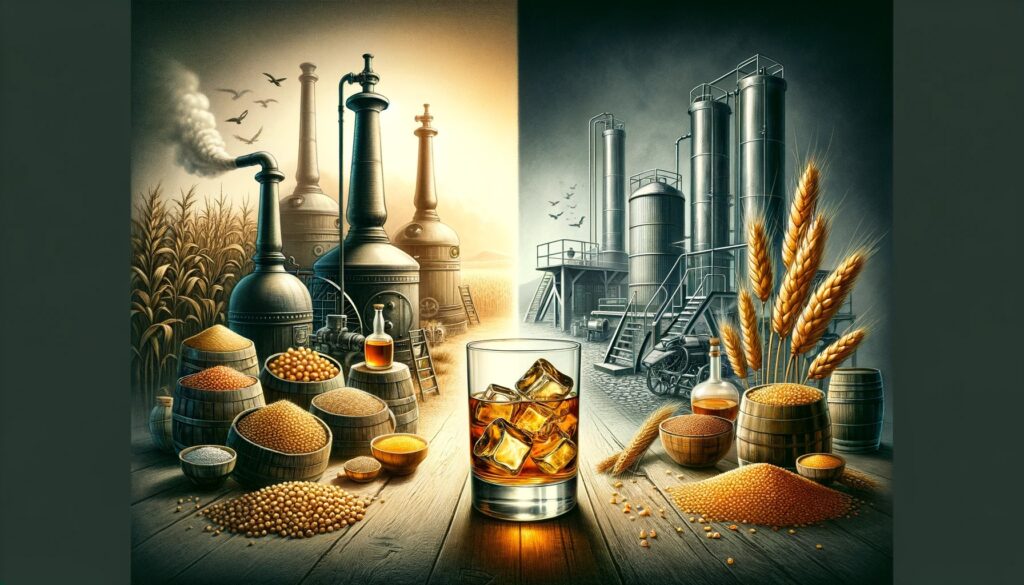
Choosing the right whiskey can be a delightful journey of discovery. Whether you’re new to the world of whiskey or looking to expand your palate, understanding the nuances of Single-Malt and Single-Grain can enhance your experience.
Tips for Beginners on Choosing Between Single-Malt and Single-Grain
- Identify Your Flavor Preferences:
- If you prefer rich, complex flavors with a depth of character, Single-Malt might be more appealing.
- For those who enjoy lighter, smoother, and sometimes sweeter notes, Single-Grain is a great choice.
- Consider the Occasion:
- Single-Malts, with their diverse profiles, are ideal for sipping and savoring, especially on special occasions.
- Single-Grain is versatile and can be enjoyed neat, on the rocks, or as a base for cocktails.
- Start with Approachable Bottles:
- Beginners may start with younger and less expensive bottles to understand their preferences without overwhelming their palate.
- Explore Different Regions:
- Experiment with whiskies from various regions to experience a range of flavors. For instance, try a Speyside Single-Malt for a smooth experience, or an Islay malt for a smoky profile.
- Read Reviews and Tasting Notes:
- Look for reviews and tasting notes to get an idea of the flavor profiles and find recommendations that align with your tastes.
Pairing Suggestions with Food
- Single-Malt Whiskey:
- Pair with hearty dishes like steak or smoked meats. The rich flavors of Single-Malt complement strong food flavors.
- For sweeter or fruitier Single-Malts, consider pairing with desserts like dark chocolate or fruit-based dishes.
- Single-Grain Whiskey:
- Great with lighter dishes like seafood or chicken. The subtle sweetness can enhance the flavors of these foods.
- Cheese pairings work well, especially with softer cheeses that align with the smoothness of Single-Grain.
- General Tips:
- Experiment with contrasts and complements. A peaty Single-Malt may contrast nicely with creamy cheeses, while a sweet Single-Grain might complement caramel desserts.
- Don’t be afraid to experiment. Whiskey and food pairings are subjective, and personal preference plays a significant role.
Selecting the right whiskey involves a mix of personal taste, experimentation, and exploration. By understanding the characteristics of Single-Malt and Single-Grain Whiskey and experimenting with food pairings, you can embark on an exciting journey through the world of whiskey and discover your personal favorites.
Conclusion
In the spirited world of whiskey, Single-Malt and Single-Grain whiskies stand as distinct embodiments of tradition, craftsmanship, and flavor. The journey through their nuances reveals much about the art of whiskey-making and the rich tapestry of tastes it offers.
Recap of Key Differences
- Ingredients: Single-Malt is made exclusively from malted barley, while Single-Grain incorporates a variety of grains, including barley, corn, wheat, or rye.
- Production Process: Single-Malt is typically distilled in pot stills and has a richer, more complex profile. Single-Grain, often distilled in column stills, tends to be lighter and smoother.
- Flavor Profiles: Single-Malt is known for its depth and range, from peaty and smoky to sweet and fruity. Single-Grain offers a subtler, often sweeter profile, making it versatile in both sipping and cocktails.
- Aging and Terroir: Both types are influenced by their aging process and geographical origins, but Single-Malt generally reflects a stronger sense of place and tradition.
Encouragement to Explore Both Types of Whiskey
Whether you are a seasoned whiskey enthusiast or a curious newcomer, the world of Single-Malt and Single-Grain whiskies offers a rich field for exploration and enjoyment. Each type brings its unique story, character, and sensory experience.
- For those who revel in complexity and tradition, the diverse regions and styles of Single-Malt whiskies await your discovery.
- If you lean towards lighter, more approachable spirits, or seek a perfect base for cocktails, Single-Grain whiskies provide a delightful and often underrated experience.
Both Single-Malt and Single-Grain whiskies hold the potential to surprise and delight with their diverse expressions. Exploring them is not just a taste journey but also a learning experience about cultures, traditions, and the subtle art of distillation. So, raise a glass, savor the flavors, and embark on an exploration of one of the world’s most beloved spirits. The world of whiskey, with its rich history and diverse styles, invites you to discover your personal preference and enjoy the timeless pleasure it offers.



